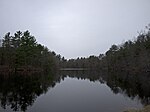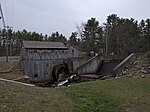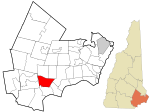Island Pond (Rockingham County, New Hampshire)

Island Pond (sometimes referred to locally as Big Island Pond) is a 532-acre (215 ha) water body located in Rockingham County in southern New Hampshire, in the towns of Derry, Hampstead and Atkinson. The pond is at the head of the Spicket River watershed, which feeds into the Merrimack River in Lawrence, Massachusetts. The pond was formed from the merger of Perch Pond in Hampstead and Lake Wentworth in Derry in 1878, when a new dam raised the water level by 8.5 feet (2.6 m).The pond is named for Governor's Island, a 231-acre (90 ha) island that lies within it. The island in turn is named for Benning Wentworth, colonial governor of New Hampshire, who built a summer residence on the north end of the island called Birch Farm. A smaller island is named after the Native American chief Escumbuit.The lake is classified as a cold and warmwater fishery and contains largemouth and smallmouth bass, brook trout, rainbow trout, brown trout, chain pickerel, horned pout, white perch, black crappie, and bluegill.
Excerpt from the Wikipedia article Island Pond (Rockingham County, New Hampshire) (License: CC BY-SA 3.0, Authors, Images).Island Pond (Rockingham County, New Hampshire)
Weston Street,
Geographical coordinates (GPS) Address Nearby Places Show on map
Geographical coordinates (GPS)
| Latitude | Longitude |
|---|---|
| N 42.8675 ° | E -71.213333333333 ° |
Address
Weston Street 18
03038
New Hampshire, United States
Open on Google Maps










